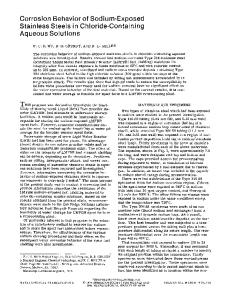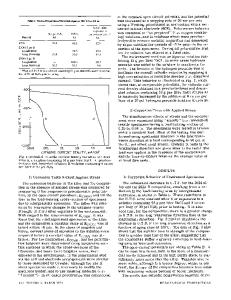Corrosion Behavior of Low Alloy Steels Containing Manganese in Mixed Chloride Sulfate Solution
- PDF / 1,325,332 Bytes
- 13 Pages / 593.972 x 792 pts Page_size
- 90 Downloads / 288 Views
I.
INTRODUCTION
ALTHOUGH low alloy steel has low cost and high strength,[1] its relatively poor corrosion resistance to most chemicals and atmospheres has limited its use. Many studies have been carried out to improve the corrosion properties and maintain the advantages of low alloy steel. The addition of small amounts of alloying elements, such as P,[2,3] C,[4,5] Cr,[6,7] Ni,[8–10] Si,[11,12] Cu,[13,14] Mo,[15,16] Sn,[17] and Nb[18] promotes the development of low-cost steel with improved corrosion resistance through the formation of an adherent, protective layer on the steel surface. Townsend[19] reported the effects of various alloying elements and impurities on the corrosion resistance of steels which contained elements, such as P, S, C, Mn, Si, Cu, Ni, Cr, As, Mo, Sn, V, W, Al, and Co. He indicated that Mn had little, if any, effect on corrosion, whereas Ellis[20] reported that Ni, P, and Mn had a beneficial effect on atmospheric corrosion for a limited number of low alloy steels. Therefore, the corrosion resistance of low alloy steel containing Mn needs to be determined. Manganese is strongly recommended as an alloying addition to iron and steel due to the advantages of its alloying properties.[21–29] In particular, manganese can combine with sulfur to form manganese sulfide inclusions (MnS), which are precursor sites for pitting corrosion.[30–34] However, the propagation and/or repassivation of pit process depend on the size[35] and geometry[36] of a MnS inclusion. The pitting of MnS is often referred to chloride environments due to the preferential adsorption of chloride ions to MnS.[35] MnS also had more dissolution rate under various applied stresses.[36,37] MnS is also a key component of low-cost steel formulations.[38] The addition of small amounts of Mn improves the workability of steel at high temperatures due to the high melting sulfide. It also prevents the formation of a liquid iron sulfide at the grain boundNGUYEN DANG NAM, Postdoctoral Research Associate, MIN JUN KIM, Doctoral Student, and JUNG GU KIM, Professor, are with the Department of Advanced Materials Science and Engineering, Sungkyunkwan University, 300 Chunchun-dong, Jangan-gu, Suwon 440-746, Republic of Korea. Contact e-mail: [email protected] Manuscript submitted May 22, 2012. METALLURGICAL AND MATERIALS TRANSACTIONS A
aries. In addition, Mn was reported to assist in the microstructural development of low alloy steel.[39,40] Bard et al.[41] reported that in the acid region, Mn dissolves in the form of the Mn2+ ions, which are stable over a wide range of potentials. In alkaline solutions, Mn2+ is hydrolyzed to Mn(OH)2, which has a narrow potential range of stability and is easily oxidized to species containing Mn(III) or (IV). Mn(III) species are strongly oxidizing in acidic solutions, and tend to disproportionate to Mn(II) and Mn(IV) species, whereas Mn(III) species form a large number of complex species with much greater stability than Mn3+ ions. The stable Mn(III) compound, Mn2O3 as well as the oxyhydroxide, MnOOH, are observed in alkaline
Data Loading...











